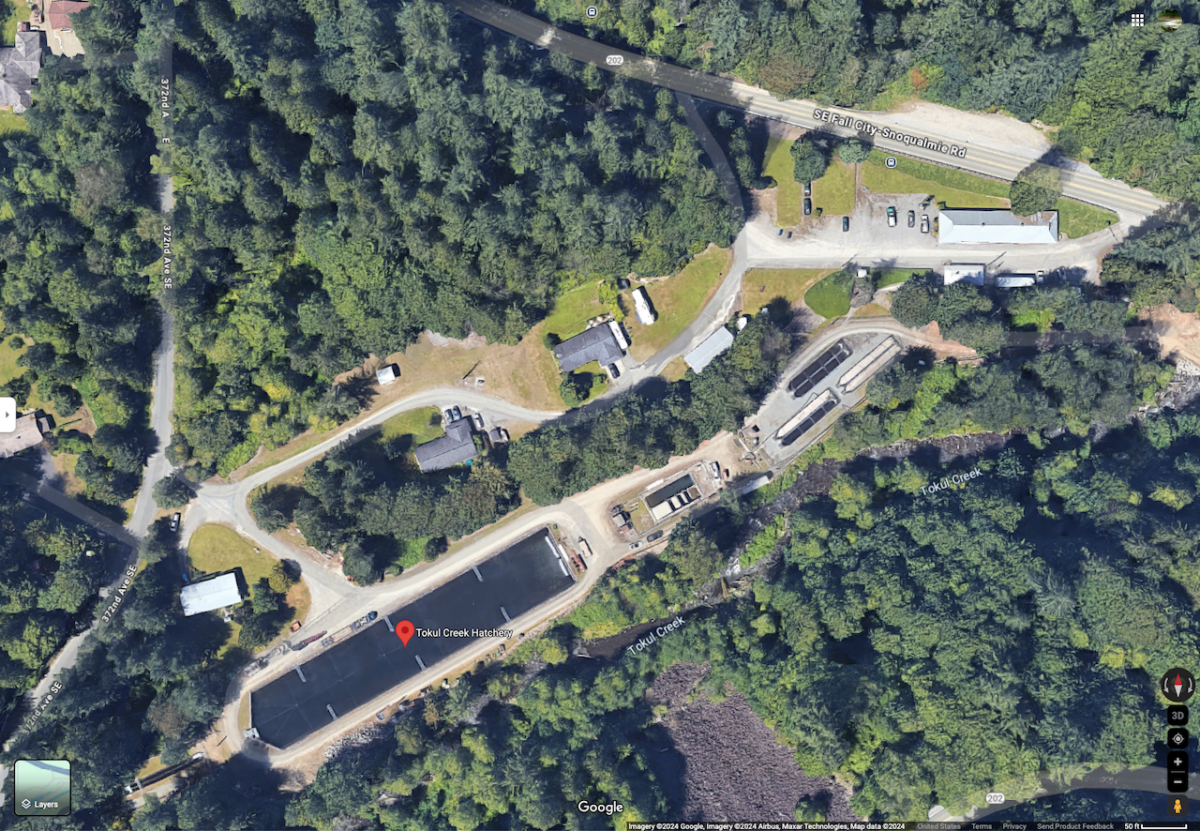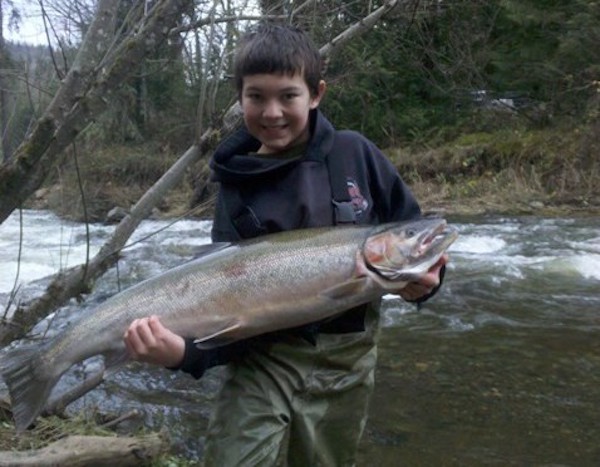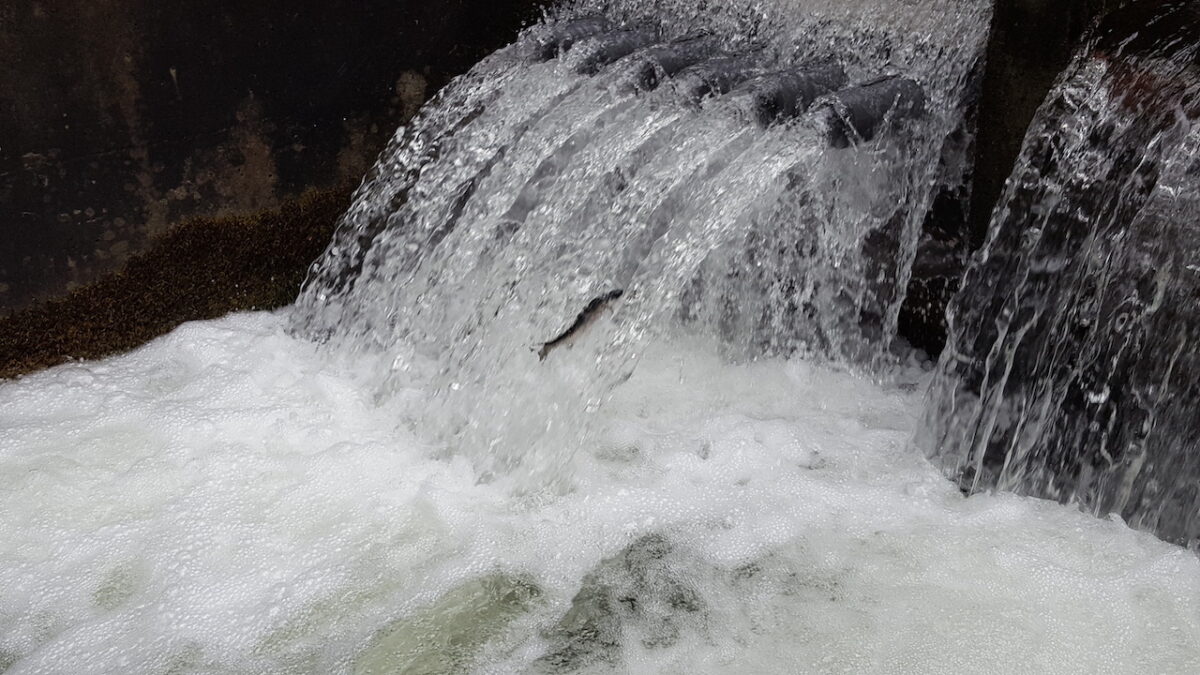
More On Why Early Winter Steelhead Releases Are Ending At Tokul Creek
The amount of hatchery steelhead genes in wild Snoqualmie winter-runs greatly exceeded allowable limits during a four-year monitoring period, and while the sample size was also relatively small, it led directly to this week’s news that the Tokul Creek program would be shut down.
It’s a big loss for anglers, acknowledges WDFW’s local fisheries manager, who will now try to get federal overseers to buy into a new broodstock program using wild fish, a bid that by my back-of-the-napkin estimate will still leave at best a four-year gap before consumptive steelheaders get back on the King County waters with a decent chance of taking one home.

It’s the latest chapter in the woes of Puget Sound steelhead that I’ve been covering since before 2007’s Endangered Species Act listing – there have also been a bright spot or two – and so for the Continuing Record, I’m going to try to expand on my fingers-of-flame blog from earlier this week to explain just exactly how we got to the end of early-timed winter-run production at Tokul Creek Hatchery. While WDFW hinted very, very broadly about it in their press release – “to reduce interbreeding between early winter hatchery and wild steelhead” – the specifics deserve more light lest hatchery production die in darkness.
I do apologize in advance if some of this ends up sounding wonky; it just is wonky as hell. There’s no two ways around that. But this isn’t 1950 anymore either. Fisheries – especially those over federally protected stocks – require a maddening amount of background … stuff … and the complexity of it all makes the often-cursed WDFW fishing regulations pamphlet look like Llama Llama Mad At Mama and other easy-reading bedtime books. So without further preramble…
AFTER THAT AFOREMENTIONED FEDERAL E.S.A. LISTING, WDFW and the Tulalip Tribes’ hatchery genetic management plans for steelhead and salmon production in the Snohomish River watershed became subject to National Marine Fisheries Service review for their impact on the population and other threatened or endangered fish such as Puget Sound Chinook and bull trout.
Throw in a lawsuit settlement with Wild Fish Conservancy and in 2014 the comanagers had to file updated HGMPs for Tokul and other Snohomish Basin hatcheries rearing and releasing Chambers Creek-strain steelhead. In April 2016, NMFS signed off on those plans via a pair of biological opinions that essentially said producing early winter-runs wouldn’t harm the listed populations.
The biops came with a series of nonnegotiable terms and conditions to ensure that too, and they require annual reports on a variety of measurements.
One is to monitor the amount of gene flow between wild and hatchery steelhead smolts and adults and do so for four consecutive years starting in 2020.
A little gene flow – technically known as proportion effective hatchery contribution, or PEHC – from clipped fish to wilds would be OK, but it also had to exhibit a downward trend over the years. The goalposts are 2 percent and 4 percent; PEHC could exceed 2 percent in the near term, but it had to be below 4 percent and, what’s more, be declining so as to get under 2 percent by the next generation of fish, 2024-27’s runs.
So, from Deming down to Duvall, WDFW busily collected and sampled unmarked winter steelhead, ran the tests, crunched the numbers, and wrote and submitted the annual reports with tribal comanagers.
The good news is that the four-year average of the maximum likely PEHC estimate for Deer Creek adult summer-run steelhead and adult winter-runs in the Pilchuck and Skykomish Rivers was 0.00. It was .01 in Nooksack smolts and .02 in Stillaguamish and Skykomish smolts.
The bad news is that on the Snoqualmie, the maximum likely PEHC estimate was .17 for adult winter steelhead and .07 for smolts, both figures greatly outside those 2 and 4 percent guardrails.
Specifically, it was .051 for adults in 2020, .488 in 2021, .087 in 2022 and .056 in 2023.
Yes, there is a downward trend exhibited in those figures from 2021 onwards; also, because of them I’d still bet a nickel on PEHC being wide right of the goalposts come 2024-27’s runs.
Exacerbating the situation is that PEHC sampling occurred during three of the six lowest returns of wild winter-runs on record since 1981 for the Snoqualmie, potentially concentrating the effect of hatchery steelhead straying onto the gravel and transmitting their less desirable genes to future year-classes. In 2023, sampling crews also caught their first marked winter steelhead since 2013 and the start of this particular protocol.

Another thing to note about the sampling is the relatively low number of unmarked fish collected on the Snoqualmie during the period of record, 2020 through 2023 – 8, 4, 2 and 16, respectively – versus the higher sampling numbers seen further back: 51 in 2015, 35 in 2016, 30 in 2014. I’m no scientist or statistician, but even assuming Covid impacted 2020 and 2021 collections during some of the worst runs on record, that actually feels like a pretty small sample size to come to the sweeping conclusion that the hatchery program needed to end.
Indeed, during last Friday’s Washington Fish and Wildlife Commission meeting, the Steelhead Trout Club of Washington’s Hal Boynton asked for more comprehensive data to be collected and reviewed before a decision and for next year’s smolts to go out in the meanwhile.
But with PEHC exceeding the hard triggers in that federal biop for the hatchery program, WDFW and the Tulalips earlier this week advised NMFS that they would stop producing early winter steelhead at Tokul. If past history is any judge, NMFS would have likely advised them to cease and desist if they hadn’t acted on their own, as the feds potentially could have faced a lawsuit themselves over not enforcing the biop’s terms and conditions.
It means that sometime in the coming months, the 74,000 Tokul smolts that would have otherwise been released next spring down the creek and out the Snoqualmie and Snohomish into the North Pacific will instead be shipped to lakes with no access to the sea. There they will at least provide some value to anglers and fishing license and taxpayer dollars, even if a fishery based on dumping river-running steelhead into landlocked ponds and whatnot (think that mid-2010s lawsuit settlement that saw a bunch sent to Sprague and Green Lakes, and Grays Harbor surplus winter-runs last year) feels about as legit as unwrapped candy dropped into your kid’s Halloween pail.

WDFW’S PLAN NOW IS TO WRITE an HGMP to switch to an integrated – meaning, using wild fish – broodstock program at Tokul Creek Hatchery. The agency gave me a cheery estimate of possibly needing as little as six months to complete the document but allowed that it was unclear how long it would then take NMFS to review (and likely ask for tweaks) and issue a new biop greenlighting broodstock collection.
Given all the other HGMPs and court cases and lawsuits and ESA listing petitions over the years that have been piled high on NMFS’s desk – strategically and otherwise – I started wondering how long it might actually be between when the last real return of Tokul winters comes back in 2025-26 and the next fishery.
Again, I’m not a state, tribal or federal biologist, hatchery manager, fishery director, plan writer or attorney, but I can use history and my past reporting on Puget Sound steelhead issues as a rough guideline. For instance, it took two years between the time WDFW and the Tulalips submitted their HGMP in spring 2019 to start a new integrated summer-run steelhead program on the Skykomish and when NMFS finally approved it in spring 2021, literally just in the nick of time to release the smolts before they residualized and wouldn’t go to sea. (It was an unusual case because of the broodstock source that essentially allowed them to be gathered, spawned and smolts reared before the HGMP was officially approved.)
So, let’s say the comanagers get cracking tomorrow, November 1, 2024, and the feds go for it after the usual back-and-forth, outside lawsuit threats and whatnot and approve it on November 1, 2026. Broodstock collection and spawning would begin in early 2027 and after being reared a year at Tokul Creek, the progeny of those fish would be released at the earliest in spring 2028. They would stay at sea until early 2030 – remember, they would be much later timed than today’s remnant Thanksgiving kickoff fish.
That would mean Snoqualmie Valley steelheaders would have a minimal fishery in 2026-27 for the few straggling three-salts from this year’s release, nothing in 2027-28 and 2028-29, and probably nothing in 2029-30, as WDFW would likely prioritize gathering broodstock from that first returning year-class of the new program over offering any angler opportunity.
That’s my Optimistic Scenario™. I would bet a dime on nothing but snags all along the way – hell, can you even collect ESA-listed fish for broodstock in a basin so far below escapement goals? – likely pushing the start of the new fishery out into the early 2030s, maybe mid-2030s.
For some, it will be worth it. If there’s one thing steelheaders know for sure, it’s that it can be a loooooooong time between bites. Recall the wait to get back on the Skagit and Sauk for wild winter-runs. The North Cascades rivers were closed in 2008 (if I recall correctly), anglers started holding hookless fish-ins at Howard Miller Steelhead Park in 2009, it took years of lobbying the Fish and Wildlife Commission to build support and then bring the tribes on board to write a new HGMP and get it approved by NMFS for a season to finally open in 2018, when enough fish returned under the plan’s sideboards. Many though not all years since have seen a fishery, sweet reward for all the work.

ALL THAT COMBINES TO MAKE THE DECISION to shut down Tokul’s early winter program pretty damned monumental.
WDFW’s regional Fish Program director Edward Eleazer can confirm. In a call, he also regretted not better acknowledging “the loss” to anglers more clearly in the agency’s press release out Tuesday.
“This is a big transition,” he told me. “This is a big deal.”
He also defended ending the early winter program and transitioning to an integrated one.
“The Snoqualmie wild steelhead decline, climate change and habitat degradation made us think long and hard about what we’re doing and how to help Snoqualmie steelhead into the future, and that’s how we landed here,” Eleazer said.
In the meanwhile, he knows there will be an extended pause in the coming years to fishing on the windy river below the famed falls.
“There’s still opportunity at Wallace and Reiter,” Eleazer reminded me. “I’m glad we moved some production to Wallace.”
Prior to the mid-2010s settlement with WFC, WDFW released 20,000 fish into the Skykomish River tributary; under the current HGMP and biop, they are allowed to stock up to 27,600. The vagaries of the ocean determine how many actually come back as adults from year to year.
At one time you might have found Eleazer himself alone on the Wallace just above the Highway 2 bridge, but with the days of scatter planting so far in the rearview mirror as to be on the other side of Stevens Pass, it’s now one of if not the most popular spots on the tiny, relatively short river as fisheries have become more and more focused on terminal zones since the listing.
“Folks are enjoying it,” Eleazer said.
That is one way to look at the combat fishery that should start getting going around Turkey Day and run into the New Year and a bit beyond – and in the not too distant future will probably see a few more Tokul Creek and Big Eddy vets shouldering their way in.
Hopefully they’ll only have to for a handful of seasons – and they stay involved in things back on their home waters, like Sky, Skagit and Sauk anglers have done on theirs.

